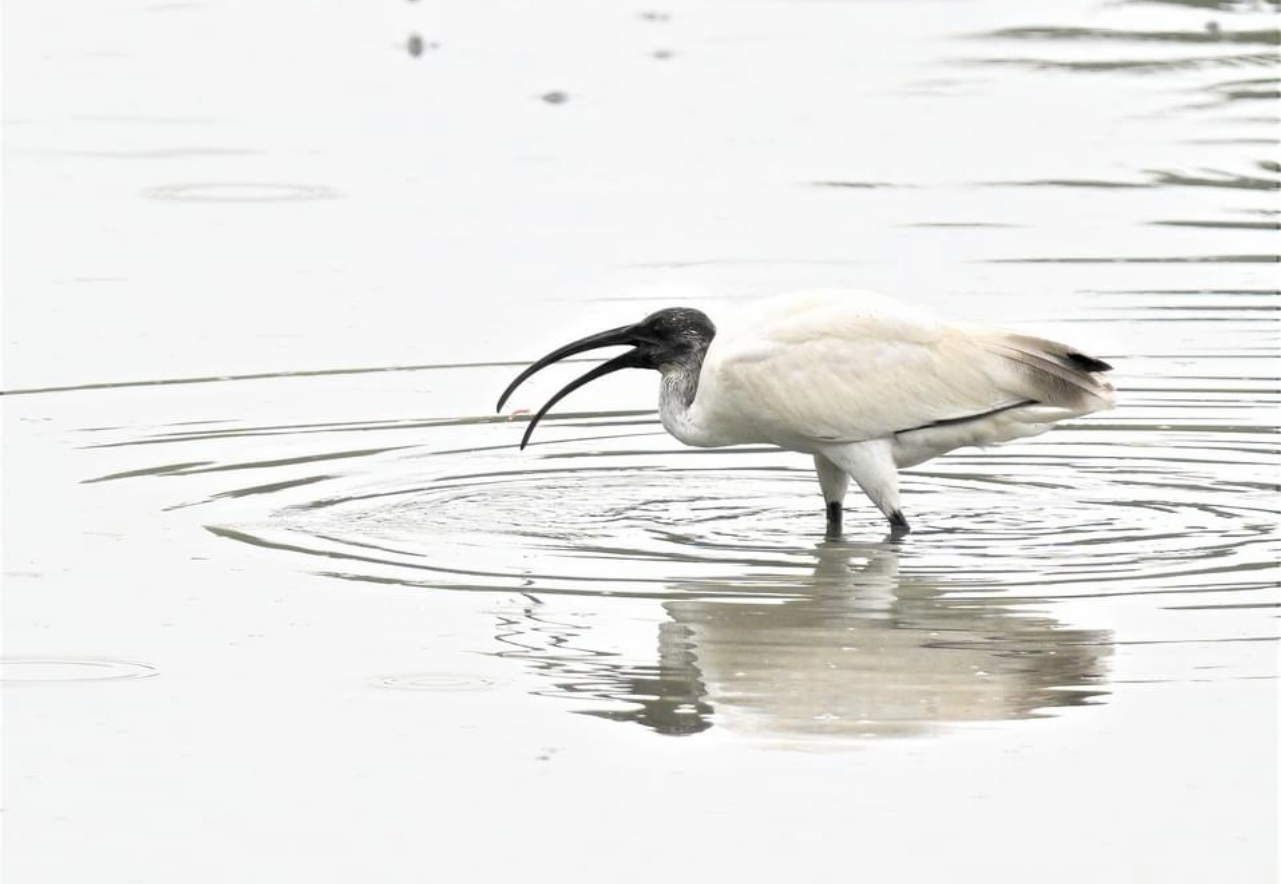On 1 November 2022, excitement spread through our local birding community when Art Toh shared his sighting from Sungei Buloh Wetland Reserve of a white ibis donning a black head. Birders headed down to get a glimpse of the bird which thankfully stayed for several days, allowing many to observe it. The Singapore Bird Records Committee took some time to evaluate the record and we assessed that this individual is likely to be Singapore’s first documented individual of a wild Black-headed Ibis Threskiornis aethiopicus.

How was the bird identified?
There are several species similar to the Black-headed Ibis such as the African Sacred Ibis T. aethiopicus, Australian Ibis T. molucca and Malagasy Sacred Ibis T. bernieri. These four species were previously all thought to be one species, then called the Sacred Ibis, until works including the evaluation of their plumage differences established that they were distinct from one another (Lowe & Richards, 1991).
The range restricted Malagasy Sacred Ibis can be differentiated from the other three by its white iris among other features. However, the Australian Ibis and African Sacred Ibis look quite similar to the Black-headed Ibis. Differences between them include their bill size, which can sometimes be difficult to assess in the field. How should we identify the Sungei Buloh bird then?
The magic is in the small details: one of the key features to look out for is the primary pattern – the black markings are restricted to tips of the three outermost primaries in Black-headed Ibis, unlike that in the African and Australian Ibis that are more extensive. Additionally, the tertial feathers in Black-headed Ibis is grey, as opposed to black in African and Australian Ibis.
Here are some images showing these features on the African Sacred Ibis (extensive primary markings: example 1, example 2 and example 3; black tertials: example 1 and example 2) and Australian Ibis (extensive primary markings example 1 and example 2; black tertials: example 1 and example 2).
Comparing the “Sungei Buloh Ibis” with photographs of known Black-headed Ibises shows that the features fit this species perfectly instead.
Is the Sungei Buloh Black-headed Ibis a wild bird or an escapee?
Now that we’ve identified the bird, then comes the question of its provenance. Interestingly, the Sungei Buloh bird is actually not the first Black-headed Ibis seen in Singapore! This species used to be sighted locally back in the ~80s but were then thought to be escapees from the Jurong Bird Park (Wang & Hails, 2007). Today, the Mandai Wildlife Reserve makes an effort to ring all birds, and there are no free-flying Black-headed Ibises as far as we understand. Sungei Buloh’s Black-headed Ibis had no rings on its leg, making it unlikely that it originated from the Jurong Bird Park.
Where could the bird have come from, then? The Black-headed Ibis has a patchy range and inhabits wetlands from South Asia all the way to Indonesia. In Thailand, they are resident in the southern parts and disperse in the winter months (Treesucon & Limparungpatthanakij). Slightly closer in Peninsula Malaysia, there might have been wild breeding populations in the past, but if any were extirpated nearly a century ago (Wells, 1999; Puan et al., 2020). There are now only very occasional sightings along the landmass (such as this record). Meanwhile in Sumatra and Java, the populations used to be very robust but have declined dramatically in the past few decades (Iqbal & Hasudungan, 2012). The birds there are, however, thankfully still present (Muhammad Iqbal, personal communications).
It is still difficult for us to establish whether the bird came from the north or from the Indonesian population. Several waterbirds like the Pied Stilt and Javan Plover have made their way from the Indonesian Archipelago. At the same time, there was, interestingly, yet another sighting of a Black-headed Ibis near Malacca just 3.5 weeks after the Sungei Buloh bird. This sighting bolsters our decision that the Sungei Buloh bird was likely from a wild origin, and might provide hints to where it could have arrived from.
Wherever the bird flew over from, we hope that it’ll successfully find some friends and return to a colony to breed safely. And who knows, we might get more of them visiting us in the future!
Acknowledgements
We would like to express our gratitude to Art for sharing the sighting very promptly, and also thank Adrian, Bao Shen and Cheng Teng for photo contributions.
References
Lowe, K. W., & Richards, G. C. (1991). Morphological Variation in the Sacred Ibis Threskironis aethiopicus Superspecies Complex. Emu, 91(1), 41-45.
Puan, C. L., Davison, G., & Lim, K. C. (2020). Birds of Malaysia: Covering Peninsular Malaysia, Malaysian Borneo and Singapore. Lynx Edicions, Barcelona.
Treesucon, U., & Limparungpatthanakij, W. (2018). Birds of Thailand. Lynx Edicions, Barcelona.
Wang, L. K., & Hails, C. J. (2007). An annotated checklist of the birds of Singapore. Raffles Bulletin of Zoology Supplement, 15, 1–179. Link






